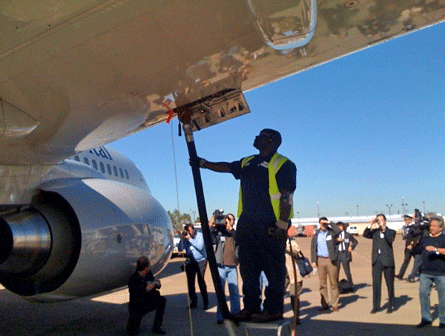Results from test flights are encouraging airlines to believe fuels from renewable sources could be in aircraft tanks in the next five years
Introduction of biofuels may be sooner than expected following recent test flights. The success of the tests could accelerate certification programmes and alternative fuels may be used commercially in the next five years.
Following the first-ever part-biofuel flight by Virgin Atlantic Airways in February 2008, Air New Zealand, Continental Airlines and Japan Airlines have all signed on for biofuel demonstrations after witnessing months of fuel price volatility.
Less than a year after Virgin Atlantic used a first-generation, 20% biofuel blend to power one of four General Electric CF6 powerplants on a Boeing 747-400, airlines have begun testing second-generation 50% biofuel mixes, in some cases on twin-engined aircraft.
ANZ then operated one Rolls-Royce RB211 engine on a 747-400 using a 50:50 biofuel blend of Jet A1 and jatropha oil during a 2h trial on 30 December in Auckland.
Continental followed with a 50:50 mix of Jet A1 and biofuel derived from 95% jatropha oil and 5% algae oil to power one of two CFM International CFM56-7B engines on a Boeing 737-800 during a 2h test on 7 January in Houston, Texas.
"It went absolutely textbook," says Continental flight-test captain Rich Jankowski, who adds that he did not expect that much difference between the fuels.
JAL will round out the demonstrations by testing a biofuel consisting of oils from camelina (84%), jatropha (under 16%) and algae (under 1%) to fly a Pratt & Whitney JT9D-powered 747-300 during a 1h flight on 30 January in Tokyo.
"Two years ago I thought we'd be lucky to get one [trial]," says Billy Glover, Boeing managing director for environmental strategy. Even six months ago, Glover says that he would not have expected three trials within six weeks.
The next steps toward commercial aviation's adoption of biofuels are likely to focus on certification rather than proof of concept as more alternative fuel trials are unlikely this year after JAL's flight test.
 |
|---|
© DomPAir New Zealand operated one Rolls-Royce RB211 engine on a 747-400 using a 50:50 biofuel blend of Jet A1 and jatropha oil |
"We're now encouraging people to look at the data collected to see what's missing before [new trial] flights," Glover says. He adds that certificating body ASTM International is not expected to request additional demonstrations, but could ask for endurance testing on specific engine components.
Recent progress has instilled so much confidence in trial partner Boeing that it decided to revise its previous forecasts for biofuel certification that it released last summer. Boeing now agrees with Honeywell's fuel technology subsidiary UOP that certification could happen with a 50% blend as opposed to a 10% blend by 2010, Boeing director of business analysis for environmental strategy Darrin Morgan says. Its expectation in July was that ASTM would approve low-percentage blends by 2013.
CERTIFICATION IN 2013
UOP, which refined drop-in fuels indistinguishable from standard jet fuel for ANZ, Continental and JAL, expects certification of a 100% biofuel to follow in 2013, UOP general manager renewable energy and chemicals Jennifer Holmgren says. She adds that there is not enough feedstock now available for mass use of a 100% biofuel.
While other parts of the supply chain work on scaling up feedstock, the Honeywell subsidiary plans to license its renewable jet fuel refining technology in the first half of 2009, she says. Once refiners purchase the licence, it is likely to take between two and two-and-a-half years to construct an alternative fuels facility, Holmgren says. With refining technology in place, biofuel production levels could reach hundreds of millions of litres by 2012, she says.
Mass production of drop-in fuels will be key for commercial adoption as fuels made from feedstocks such as algae and plants such as jatropha and camelina are compatible with existing infrastructure such as tanks, pipelines and aircraft engines, UOP says. Commercial adoption could lag if the use of biofuels required major infrastructure challenges, it adds. Earlier alternative fuels such as ethanol or biodiesels are not compatible with the infrastructure, UOP adds.
Another advantage of a drop-in fuel is the ability to work across different feedstocks. The logistics of using only one feedstock would be "insane", and infrastructure costs such as storage would increase if feedstocks could not be combined, Holmgren says. The goal is to make alternative fuels "completely feedstock agnostic", allowing for different, regional solutions.
Economics and environmental concerns were among the motivating factors for the latest alternative fuel trials.
Bringing another fuel source to the market helps to stabilise pricing, which is important when fuel accounts for 25-40% of costs and the price of fuel is expected to increase, Continental chief executive Larry Kellner says.
 |
|---|
© ContinentalContinental's trial used a 50:50 mix of Jet A1 and biofuel derived from 95% jatropha and 5% algae |
While Jet A1 and biofuel emit roughly the same amount of carbon dioxide in flight, overall emissions savings are realised during the production of biofuels, which unlike Jet A1, absorb CO2. Second-generation biofuels also carry the benefit of not affecting the food supply or contributing to deforestation, as was the case with first-generation fuels, Kellner adds.
One difference between the latest trials and the Virgin Atlantic demonstration is that the UK carrier used feedstocks generally understood to compete with either land and water use for food crops or carbon sinks such as rainforests.
"The idea was to demonstrate biofuel, but it wasn't a feedstock you might use, because of the overall environmental impact," says Lourdes Maurice, US Federal Aviation Administration chief technical scientist and technical adviser for environment and energy. More feedstocks and testing options have become available since the Virgin Atlantic flight, she adds. "The knowledge base is increasing very rapidly," says Maurice, who in addition is leading the environmental team for the USA's Commercial Aviation Alternative Fuels Initiative (CAAFI).
CERTIFICATION INFORMATION
Another difference from the Virgin Atlantic flight is that stakeholders in the latest trials worked with CAAFI and ASTM to determine what information would be needed to achieve certification, so ANZ, JAL and Continental's demonstrations were tailored accordingly, Maurice says.
 |
|---|
© Megan Kuhn/FlightglobalContinental fuels up before its trial |
As a result, ANZ and Continental operated performance tests at various altitudes under a variety of operating conditions to measure the biofuel's performance through the affected engine and fuel system. Testing took place at take-off, climb, cruise and descent.
ANZ says there was a typical full-powered take-off and, as the aircraft was between 20,000ft (7,620m) and 25,000ft, the No 1 engine fuel pump was switched off to check for fuel lubricity.
At 35,000ft, at cruise height, the Auckland airline checked engine pressure ratios and other performance parameters.
Deceleration and acceleration tests were carried out by both carriers, along with two in-flight engine shutdowns and restarts - one windmill start and one starter assist. And each of the airlines simulated a missed approach and go-around to test engine performance at maximum thrust, followed by performance of a normal landing.
In its forthcoming demonstration, JAL will also monitor engine performance during normal and non-normal flight operations, which will include quick accelerations and decelerations, and engine shutdown and restart, JAL environmental affairs vice-president Yasunori Abe says.
ANZ, Continental and JAL will analyse test data and report findings mid-year to ASTM, says UOP's Holmgren.
Boeing, in conjunction with Yale University, is also analysing the carbon lifecycle properties of jatropha for aviation use, says ANZ chief pilot, Capt David Morgan, adding that a report will be published in late 2009.
Participating airlines appear pleased with initial results. Continental found that the thrust setting of the engines was the same, but fuel flow and exhaust gas temperature was slightly less for the engine using the biofuel blend, Jankowski says.
The biofuel-blend-powered engine burned slightly less fuel than the engine powered by Jet A1 for the same thrust setting, Continental manager of training standards Capt Jackson Seltzer says.
Source: Flight International























